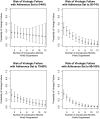The risk of virologic failure decreases with duration of HIV suppression, at greater than 50% adherence to antiretroviral therapy
- PMID: 19787058
- PMCID: PMC2747009
- DOI: 10.1371/journal.pone.0007196
The risk of virologic failure decreases with duration of HIV suppression, at greater than 50% adherence to antiretroviral therapy
Abstract
Background: We hypothesized that the percent adherence to antiretroviral therapy necessary to maintain HIV suppression would decrease with longer duration of viral suppression.
Methodology: Eligible participants were identified from the REACH cohort of marginally housed HIV infected adults in San Francisco. Adherence to antiretroviral therapy was measured through pill counts obtained at unannounced visits by research staff to each participant's usual place of residence. Marginal structural models and targeted maximum likelihood estimation methodologies were used to determine the effect of adherence to antiretroviral therapy on the probability of virologic failure during early and late viral suppression.
Principal findings: A total of 221 subjects were studied (median age 44.1 years; median CD4+ T cell nadir 206 cells/mm(3)). Most subjects were taking the following types of antiretroviral regimens: non-nucleoside reverse transcriptase inhibitor based (37%), ritonavir boosted protease inhibitor based (28%), or unboosted protease inhibitor based (25%). Comparing the probability of failure just after achieving suppression vs. after 12 consecutive months of suppression, there was a statistically significant decrease in the probability of virologic failure for each range of adherence proportions we considered, as long as adherence was greater than 50%. The estimated risk difference, comparing the probability of virologic failure after 1 month vs. after 12 months of continuous viral suppression was 0.47 (95% CI 0.23-0.63) at 50-74% adherence, 0.29 (CI 0.03-0.50) at 75-89% adherence, and 0.36 (CI 0.23-0.48) at 90-100% adherence.
Conclusions: The risk of virologic failure for adherence greater than 50% declines with longer duration of continuous suppression. While high adherence is required to maximize the probability of durable viral suppression, the range of adherence capable of sustaining viral suppression is wider after prolonged periods of viral suppression.
Conflict of interest statement
Figures
References
-
- Paterson DL, Swindells S, Mohr J, Brester M, Vergis EN, et al. Adherence to protease inhibitor therapy and outcomes in patients with HIV infection. Ann Intern Med. 2000;133:21–30. - PubMed
-
- Bangsberg DR, Hecht FM, Charlebois ED, Zolop AR, Holodniy M, et al. Adherence to protease inhibitors, HIV-1 viral load, and development of drug resistance in an indigent population. AIDS. 2000;14:357–366. - PubMed
-
- Bangsberg DR. Less than 95% adherence to nonnucleoside reverse-transcriptase inhibitor therapy can lead to viral suppression. Clin Infect Dis. 2006;43:939–941. - PubMed
-
- Shuter J. Forgiveness of non-adherence to HIV-1 antiretroviral therapy. J Antimicrob Chemother. 2008;61:769–773. - PubMed
Publication types
MeSH terms
Substances
Grants and funding
LinkOut - more resources
Full Text Sources
Medical
Research Materials


